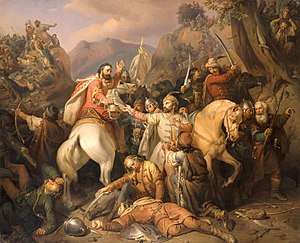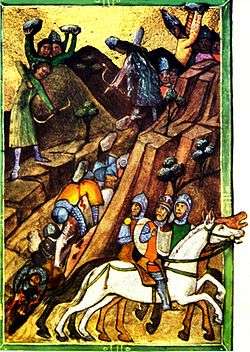Battle of Posada
The Battle of Posada (November 9, 1330 – November 12, 1330)[3] was fought between Basarab I of Wallachia and Charles I of Hungary (also known as Charles Robert).
| Battle of Posada | |||||||
|---|---|---|---|---|---|---|---|
| Part of the Hungarian-Wallachian Wars | |||||||
 Dezső sacrifices himself protecting Charles Robert. by József Molnár, oil on canvas in 1855 | |||||||
| |||||||
| Belligerents | |||||||
|
|
| ||||||
| Commanders and leaders | |||||||
| Charles I Robert | Basarab I | ||||||
| Strength | |||||||
| 30,000[2] | 7,000–10,000[2] | ||||||
| Casualties and losses | |||||||
| Very heavy[2] | Light[2] | ||||||
The small Wallachian army led by Basarab, formed of cavalry and foot archers, as well as local peasants, managed to ambush and defeat the 30,000-strong Hungarian army, in a mountainous region near the border between Oltenia and Severin.
The battle resulted in a major Wallachian victory and disaster for Charles Robert, becoming a turning point in the politics of Hungary, which had to abandon its hopes of extending the kingdom to the Black Sea. For Wallachia, the victory meant an increase in morale and the further evolution of the independent state.
Background

Some historians claim that the Cumans aided the Wallachians in the battle. Still in the Hungarian army there was a substantial Cuman-Hungarian contingent so this variant is very improbable. In 1324, Wallachia was a vassal of Hungary, and Robert referred to Basarab as "our Transalpine Voivode".[4]
The war started with encouragement from the Voivode of Transylvania[5] and a certain Dionisie, who later bore the title Ban of Severin.[4] In 1330, Robert captured the long disputed Wallachian citadel of Severin and handed it to the Transylvanian Voivode.[5]
Basarab sent envoys who asked for the hostilities to cease, and in return offered to pay 7,000 marks in silver, submit the fortress of Severin to Robert, and send his own son as hostage.[5] According to the Viennese Illuminated Chronicle, a contemporary account, Robert said about Basarab: "He is the shepherd of my sheep, and I will take him out of his mountains, dragging him by his beard." Another account writes that Robert said that: "...he will drag the Voivode from his cottage, as would any driver his oxen or shepherd his sheep."[5]
The King's councillors begged him to accept the offer or give a milder reply, but he refused and led his 30,000-strong army deeper into Wallachia "without proper supplies or adequate reconnaissance".[5] Basarab was unable to stand a battle in the open field against a large army, due to the poor state of his troops, and he decided to retreat somewhere into the Transylvanian Alps.
Robert entered Curtea de Argeș, the main city of the Wallachian state. He realised that Basarab had fled into the mountains and decided to give chase.
Battle
The location of the battle is still debated among historians. One theory gives the location of the battle at Loviştea, in some mountain gorges, in the valley of Olt, Transylvania.[4] However, Romanian historian Neagu Djuvara denies this and states that the location of the battle was somewhere at the border between Oltenia and Severin.[6]
The Wallachian army, led by Basarab himself, probably numbered less than 10,000 men and consisted of cavalry, infantry archers, and some locally recruited peasants.[7] When Robert saw his best knights being killed, without being able to fight back, while the escape routes were blocked by the Wallachian cavalry, he gave his royal robes and insignia to one of his captains – "who dies under a hail of arrows and stones" – and, with a few loyal subjects, made a difficult escape to Visegrád "clad in dirty civilian clothes".[5]
Robert later recounted in detail, in a charter of December 13, 1335, how one "Nicholas, son of Radoslav", saved his life by defending him from the swords of five Wallachian warriors, giving him enough time to escape.[4] Most of the Hungarian army – which included many nobles – was destroyed; among the casualties were the Voivode of Transylvania and the priest who accompanied the king.[5]
Aftermath
The victory represented the survival of the Wallachian state, as well as the beginning of a period of tense relations between Basarab and the Kingdom of Hungary, which lasted until 1344, when Basarab sent his son Alexandru in order to re-establish a relationship between the two states.
Because of its large financial power, the Kingdom of Hungary quickly rebuilt its army and found itself in conflict with the Holy Roman Empire in 1337. However, the Hungarian king maintained a de jure suzerainty over Wallachia until the diplomatic disputes had been resolved.[8]
Footnotes
- Djuvara, pp.190 – "Când ultimii scăpaţi teferi din marea oaste a lui Carol cel Mare s-au pierdut în noapte, au rămas in mâinile românilor o mulţime de prizonieri şi o uriaşă pradă...".
- Djuvara, pp.172–180
- Djuvara, pp.19 – "... marea bătălie zisă de la Posada (9–12 noiembrie 1330);".
- Ghyka, p. 59.
- Dlugosz, p. 278.
- Djuvara, pp.181–182 – "...atacul lui Basarab împotriva armatei ungare are loc când aceasta a ajuns la acele margini ale regatului pe care Basarab, în concepţia suzeranului Carol Robert, le deţinea pe nedrept – acelea nu puteau fi decât la graniţa Olteniei, inăuntrul banatului de Severin, ...".
- Djuvara, pp.184–186 – "Ne putem închipui manevra lui Basarab: văzând calea pe care a apucat armata ungară, a depăşit-o în marş forţat cu oastea sa de cavaleri şi cu pedestrime de arcaşi din oastea mare. A strâns din ţăranii şi pădurarii locului de au pregătit acele prisăci, tăieri de copaci şi întărituri. Cei care, de pe dealurile înconjurătoare, îi copleşesc sub ploaie de săgeţi pe cavaleri sunt mai probabil unităţi de arcaşi pedeştrii."
- Djuvara, pp.190–195 – "...Basarab l-ar fi trimis prin 1343 sau 1344, pe fiul său Alexandru, asociat la domnie, pentru a restabili legăturile cu regele Ungariei, ...".
References
- Długosz, Jan & Michael, Maurice. The Annals of Jan Długosz. (Abridged edition). IM Publications, 1997. ISBN 1-901019-00-4
- Ghyka, Matila. A Documented Chronology of Roumanian History – from prehistoric times to the present day. Oxford 1941.
- Djuvara, Neagu. Thocomerius – Negru Voda. Un voivod de origine cumana la inceputurile Tarii Romanesti. Bucharest: Humanitas, 2007. ISBN 978-973-50-1731-6.